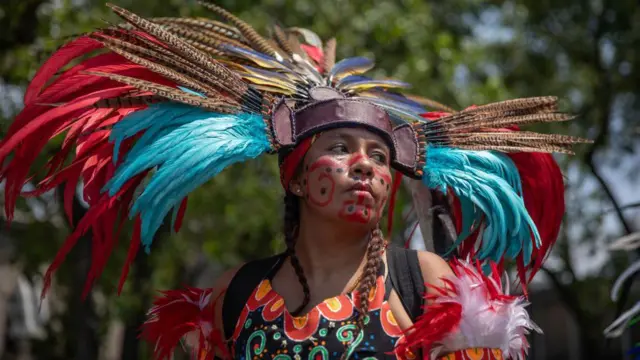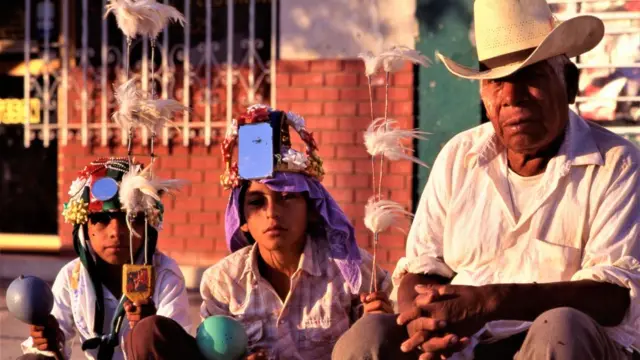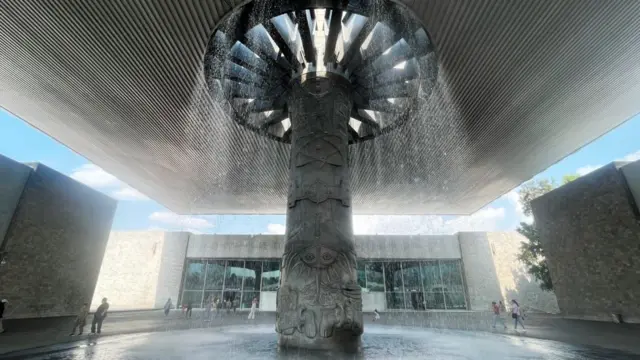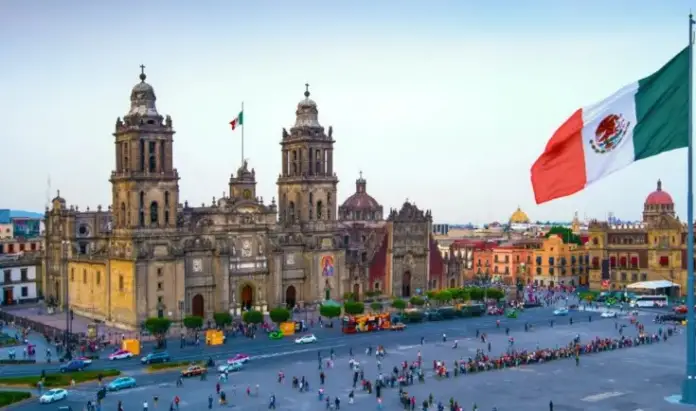There are things that are great because of their size, and others that are great because of their symbolism.
The National Museum of Anthropology in Mexico City is great in both senses.
And that is why, the first time I went, it seemed more grandiloquent than grand.
“Courage and confidence in the future are found by people in the greatness of their past,” says a poem by the writer Jaime Mario Torres Bodet carved on a huge marble wall at the entrance to the imposing complex.
And it continues: “Mexican, look at yourself in the mirror of that greatness. See here, foreigner, the unity of human destiny.”
At first, the idea that Mexico summons the destinies of humanity sounded somewhat vain to me, somewhat self-absorbed.
Then I visited the museum for the second time. And third, and fourth. In nine months in Mexico, I have already visited this gallery five times, which, in effect, contains the history of a region, but serves as a window to the world, to the human being.
“This is mainly the history of Mesoamerica, it’s true,” Antonio Saborit, historian and director of the Museum, told me, while we were looking at the enormous fountain in the courtyard, which tells the story of the origin of everything, and the history of Mexico, on a stone column.
“But if you think about the parallels there are with other civilizations, from the Egyptian to the Chinese, you will find that yes, this place actually contains the history of humanity,” added Saborit.
At that moment I understood Torres Bodet’s point: more than a presumptuous gesture, what lies behind these words is a worldview, a historical belief, that Mexicans have of themselves, and that the rest of Latin Americans have much less.
It is the idea, present since pre-Hispanic times, that this is the center of the universe and the origin of things. Something that in many ways is, as I thought a priori, exaggerated. But it reveals the magnitude – the arrogance in the broadest sense of the word – of a country that is actually a civilization and could well be considered a continent.
This 2024 was the year that I arrived in Mexico after a decade covering the rest of Latin America. It was the year that I understood that this country is not like the others. And I am going to tell you the main differentiating variables that I found.

“The best country in the world”
In addition to visiting the Anthropology Museum, this year I covered the coming to power of Claudia Sheinbaum, a scientist, environmentalist and former mayor who became the first female president in history.
And something that surprised me about her campaign speeches, and already as president, is that she repeated a phrase: “This is the best country in the world.”
“For its culture, its traditions, its places, its gastronomy and its people,” said the then candidate. “We are going to continue making Mexico the best country in the world,” she promised.
And people responded with encouragement.
All nations feel —perhaps they are— the best at something: my country, Colombia, sees itself as “the best place to live in the world.”
But, despite all that, in Mexico I find superlatives of that style on every corner: the largest city, the longest metrocable, the spiciest food. I even recently did a report on “the most Mexican city.”
Here everything is the best. And sometimes it is true; sometimes not. What is interesting, more than whether they are, is the belief: what has to happen in the history of a people to develop a grandiose perception of itself?
Sheinbaum. and indigenous people Image source,Getty Images
Caption,Sheinbaum was sworn in as president in a ceremony that showed the power and validity of pre-Hispanic cultures in Mexico.
Much, I believe, has to do with the pre-Hispanic history of Mexico, which is not only limited to the Aztec Empire, the last, the largest, the bloodiest, but also includes vast and complex civilizations such as the Mayans, the Toltecs, the Mixtecs, the Olmecs, the Huastecos and the Zapotecs.
In almost all of these cultures, in different ways, there was a worldview that started from feeling like the center of the world; in cultural and political terms, but above all geographical and astrological. They are the civilizations that gave the world corn, cotton, and the domestication of dogs, among other things.
Only in one region of America was there a civilization as powerful—again, in the broadest sense of the word—as the Mesoamericans: where Peru is today.
The Inca Empire, like the Aztecs, expanded its government to a diversity of peoples who ended up articulated under a myth, a cause: to be the center of the world.
Cusco, like Tenochtitlán, was considered the origin of everything. And in Peru, as in Mexico, much of the pre-Hispanic legacy lives on: in its gastronomy, in its rituals, in its crafts.
But it is not common, I understand, for a Peruvian politician or citizen to speak of his country as “the best in the world.” In Mexico, on the other hand, they say it from the president down.
“As long as the world remains, the fame and glory of Mexico-Tenochtitlan will not end,” says another of the phrases carved on the walls of the Anthropology Museum. It is from the Nahua indigenous historian Chimalpahin in the 16th century.
My point is this: Mexicans think, perhaps in a more pronounced way than the rest of Latin Americans, that their nation is made for great things.

Big, in every sense
And when I say big things, I also mean it in literal terms.
Because in Mexico everything is big: the portions of food, the piñatas, the highways, the trucks, the squares, the doors, the sculptures.
It’s not just that they’re big: it’s that they’re on a Mexican scale.
I thought about it the day I went to a supposed Spanish tapas place in the San Juan market in Mexico City, where they sell bread with ham and cheese like in Spain but in such a quantity, in a tower that it doesn’t fit in your mouth, that for a Spaniard it would be a scandal. Not here: it’s the way of doing things. On a big scale. Exaggerated.
As much as a torta ahogada, a band of corridos tumbados, a michelada beer with goma, tamarind and chili.
These are things inherited from other cultures, but taken to a Mexican scale. Thought on a big scale, in every sense of the word.
Or as writer Carlos Padilla told BBC Mundo in a recent report on the paste, a Mexican empanada brought from England: “The paste is a great example of what we do in Mexico: everything that comes to us, we improve it, especially with the food.”
Neighbors from the center of the world
In terms of magnitude, then, the only country in the region comparable to Mexico is Brazil —which, again, could well be considered a continent. But with two differences.
Mexico, first, is a border with the world’s leading power during the 20th century and what we have seen of the 21st, a neighborhood that marks its economy, its culture, its politics and, well, the size of the food portions, because in the United States they have the same.
There is something about belonging to North America that makes Mexico something different from the other Latin American countries.
It’s not just that half of Hollywood lives here, and that half of Hollywood depends on Mexican labor, but also that free trade agreements with global impact are signed in Mexico, that suddenly the country is a key point of globalization, that people from all over the world pass through here wanting to migrate to the north, that this has been the center of the world —yes— for important literary, feminist, and architectural movements.
The turning point
And that proximity to the United States is not the only thing that differentiates Mexico from Brazil, and from the rest of the region: it is also its Revolution, with a capital R.
At the beginning of the 20th century, when most of the region was still governed by aristocratic elites inherited from the Colony, Mexico experienced a popular revolt that marks it to this day.
This was the first country in Latin America to carry out an agrarian reform, to guarantee workers’ rights, to develop a national system of public education, to institutionalize a notion of the public, to prioritize investment in culture and education and to consolidate a political and cultural narrative about the content of the nation.
This marked the entire region: from Argentine Peronism to the Cuban revolution, passing through the mestizo identity movement of Getulio Vargas in Brazil; it is difficult to think of a popular movement in Latin America that was not inspired by the Mexican case.
Whether they achieved their goals is another thing. Whether they were right is another. Whether in Mexico the democratic principles of the Revolution were reversed by corruption and violence is another.

But that feeling, that precedent, that the people came to power to govern in their favor, that at some point their struggles and identities were vindicated, is something that happened in Mexico from the start.
And something that is more current here than anywhere else: Sheinbaum and her movement, for example, see themselves as a “transformation” as profound – and in the same line – as the Revolution.
Perhaps all this reflection comes down to my not at all pioneering discovery that Mexico, like all countries, looks different from the outside than from the inside.
Another thing I discovered, to give you another example, is that Chavo del 8 here is viewed with suspicion, while in the rest of the region he is an object of worship.
There are things, of course, in which Mexico is the same as the rest: the language, the religion, the inequality, the violence, the machismo.
I’m not saying that it’s not Latin America, or that it’s the best country in the world: I’m just saying that Mexico is different.
Source: bbc




